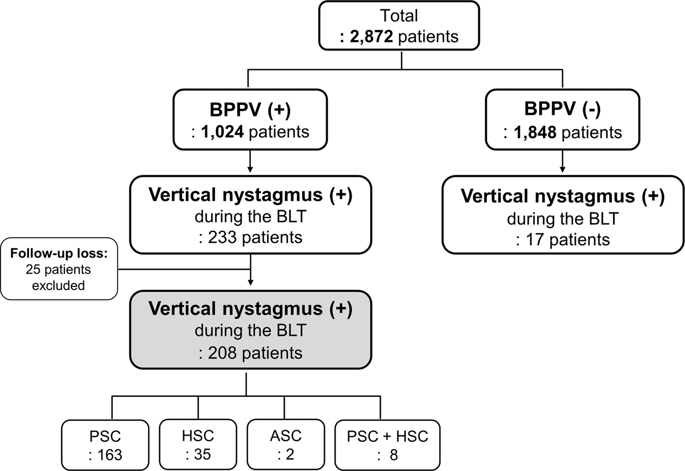Our official English website, www.x-mol.net, welcomes your
feedback! (Note: you will need to create a separate account there.)
Vertical Nystagmus in the Bow and Lean Test may Indicate Hidden Posterior Semicircular Canal Benign Paroxysmal Positional Vertigo: Hypothesis of the Location of Otoconia.
Scientific Reports ( IF 3.8 ) Pub Date : 2020-04-16 , DOI: 10.1038/s41598-020-63630-3 Oak-Sung Choo 1, 2 , Hantai Kim 1, 2 , Jeong Hun Jang 1 , Hun Yi Park 1 , Yun-Hoon Choung 1, 2, 3
Scientific Reports ( IF 3.8 ) Pub Date : 2020-04-16 , DOI: 10.1038/s41598-020-63630-3 Oak-Sung Choo 1, 2 , Hantai Kim 1, 2 , Jeong Hun Jang 1 , Hun Yi Park 1 , Yun-Hoon Choung 1, 2, 3
Affiliation

|
The 'Bow and Lean Test' (BLT) was developed for proper diagnosis of horizontal semicircular canal benign paroxysmal positional vertigo (HSC-BPPV). Occasionally, down- and/or up-beating vertical nystagmus is observed during the BLT. This study analyzed patients who exhibited vertical nystagmus in the BLT to comprehend the clinical significance of this sign. Of 2872 patients with vertigo between 2010 and 2015, 225 patients who showed vertical nystagmus in the BLT were enrolled. All patterns of vertical nystagmus were described based on their types of BPPV. After performing therapeutic maneuvers for BPPV, remnant symptoms in the BLT findings were investigated. Of the 225 patients with vertical nystagmus, 163 were posterior semicircular canal BPPV (PSC-BPPV). Down-beating in the bowing position and no nystagmus in the leaning position ('Down/-') was the most common type (190 of 225 patients). In addition, the nystagmus occurred in the form of '-/Up', 'Down/Up', and '-/Down'. The pattern of vertical nystagmus may be related to the position of otoconia in the canals. The location of the otoconia enables the diagnosis of hidden PSC-BPPV. Even after treatment for BPPV, patients with vertical nystagmus in the BLT tended to complain remnant vertigo symptoms (44.8% vs. 23.9%, P = 0.022, in PSC-BPPV; 70.0% vs. 24.0%, P = 0.020, in HSC-BPPV). We thought that they actually had hidden PSC-BPPV and the otoconial debris may still in the PSC; this untreated PSC-BPPV might cause the remnant symptoms. In conclusion, vertical nystagmus in the BLT may indicate the presence of PSC-BPPV. Moreover, vertical nystagmus during the BLT may occur in patients with hidden PSC-BPPV who complain of remnant vertigo symptoms. Vertical nystagmus shown in the BLT may not include the possibility of central vertigo.
中文翻译:

弓箭和倾斜测试中的垂直眼球震颤可能表明隐匿性后半圆形管良性阵发性位置性眩晕:耳托科位置的假设。
开发了“弓和瘦测试”(BLT),用于正确诊断水平半规管良性阵发性位置性眩晕(HSC-BPPV)。有时,在BLT期间会观察到垂直跳动的上下震颤。这项研究分析了在BLT中表现出垂直眼球震颤的患者,以了解该体征的临床意义。在2010年至2015年之间的2872例眩晕患者中,有225例在BLT中显示垂直眼球震颤的患者入组。垂直眼球震颤的所有模式均根据其BPPV类型进行了描述。在对BPPV进行治疗后,对BLT发现的残余症状进行了调查。在225例垂直眼球震颤患者中,有163例为后半规管BPPV(PSC-BPPV)。俯卧位拍打不下,俯卧位无眼球震颤(' Down /-)是最常见的类型(225名患者中的190名)。另外,眼球震颤以“-/上”,“下/上”和“-/下”的形式发生。垂直眼球震颤的模式可能与耳垢在耳道中的位置有关。耳石的位置可以诊断隐藏的PSC-BPPV。即使在接受BPPV治疗后,BLT中垂直眼球震颤的患者也倾向于抱怨残留的眩晕症状(PSC-BPPV中44.8%vs. 23.9%,P = 0.022; HSC-70.0%vs. 24.0%,P = 0.020)。 BPPV)。我们以为他们实际上已经隐藏了PSC-BPPV,耳膜碎片可能仍在PSC中。未经处理的PSC-BPPV可能会导致残留症状。总之,BLT中的垂直眼球震颤可能表明存在PSC-BPPV。此外,隐匿性PSC-BPPV患者抱怨残余眩晕症状,可能发生BLT期间的垂直眼球震颤。BLT中显示的垂直眼球震颤可能不包括中枢性眩晕的可能性。
更新日期:2020-04-24
中文翻译:

弓箭和倾斜测试中的垂直眼球震颤可能表明隐匿性后半圆形管良性阵发性位置性眩晕:耳托科位置的假设。
开发了“弓和瘦测试”(BLT),用于正确诊断水平半规管良性阵发性位置性眩晕(HSC-BPPV)。有时,在BLT期间会观察到垂直跳动的上下震颤。这项研究分析了在BLT中表现出垂直眼球震颤的患者,以了解该体征的临床意义。在2010年至2015年之间的2872例眩晕患者中,有225例在BLT中显示垂直眼球震颤的患者入组。垂直眼球震颤的所有模式均根据其BPPV类型进行了描述。在对BPPV进行治疗后,对BLT发现的残余症状进行了调查。在225例垂直眼球震颤患者中,有163例为后半规管BPPV(PSC-BPPV)。俯卧位拍打不下,俯卧位无眼球震颤(' Down /-)是最常见的类型(225名患者中的190名)。另外,眼球震颤以“-/上”,“下/上”和“-/下”的形式发生。垂直眼球震颤的模式可能与耳垢在耳道中的位置有关。耳石的位置可以诊断隐藏的PSC-BPPV。即使在接受BPPV治疗后,BLT中垂直眼球震颤的患者也倾向于抱怨残留的眩晕症状(PSC-BPPV中44.8%vs. 23.9%,P = 0.022; HSC-70.0%vs. 24.0%,P = 0.020)。 BPPV)。我们以为他们实际上已经隐藏了PSC-BPPV,耳膜碎片可能仍在PSC中。未经处理的PSC-BPPV可能会导致残留症状。总之,BLT中的垂直眼球震颤可能表明存在PSC-BPPV。此外,隐匿性PSC-BPPV患者抱怨残余眩晕症状,可能发生BLT期间的垂直眼球震颤。BLT中显示的垂直眼球震颤可能不包括中枢性眩晕的可能性。





















































 京公网安备 11010802027423号
京公网安备 11010802027423号